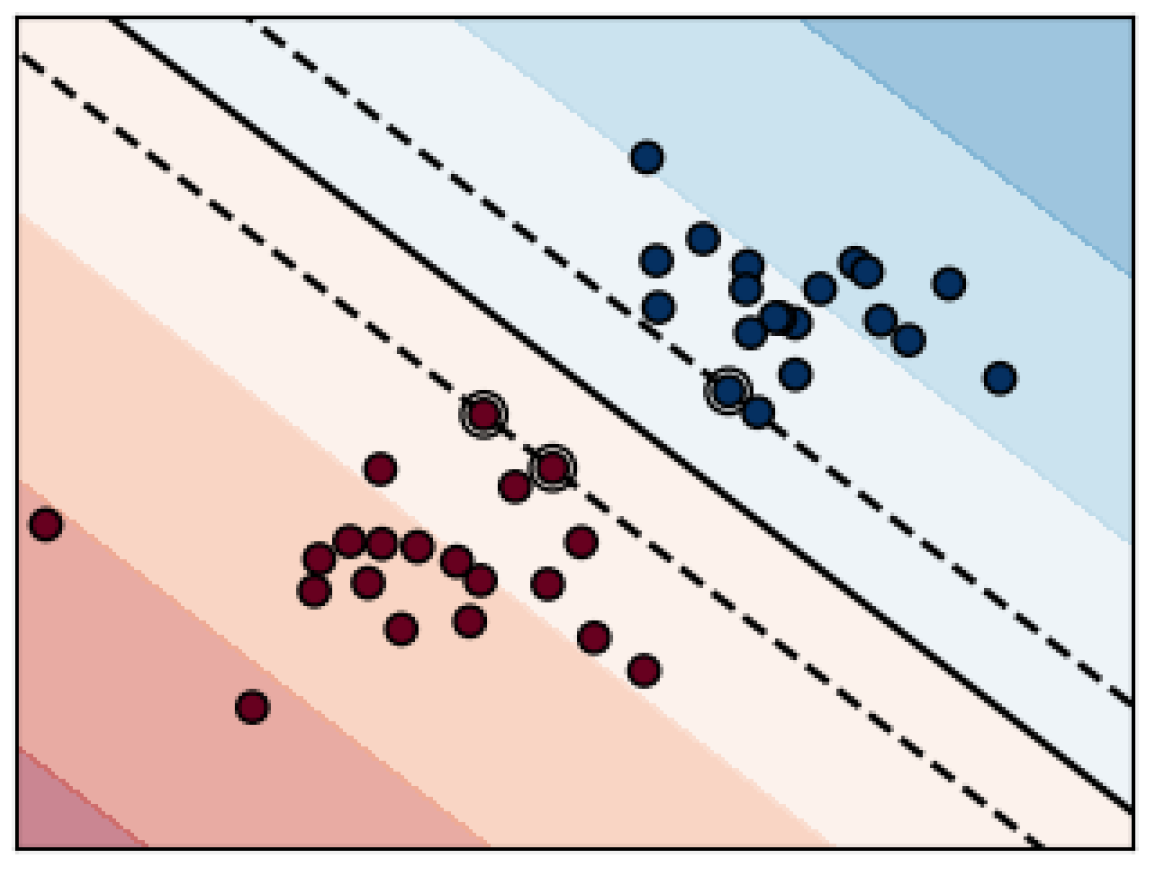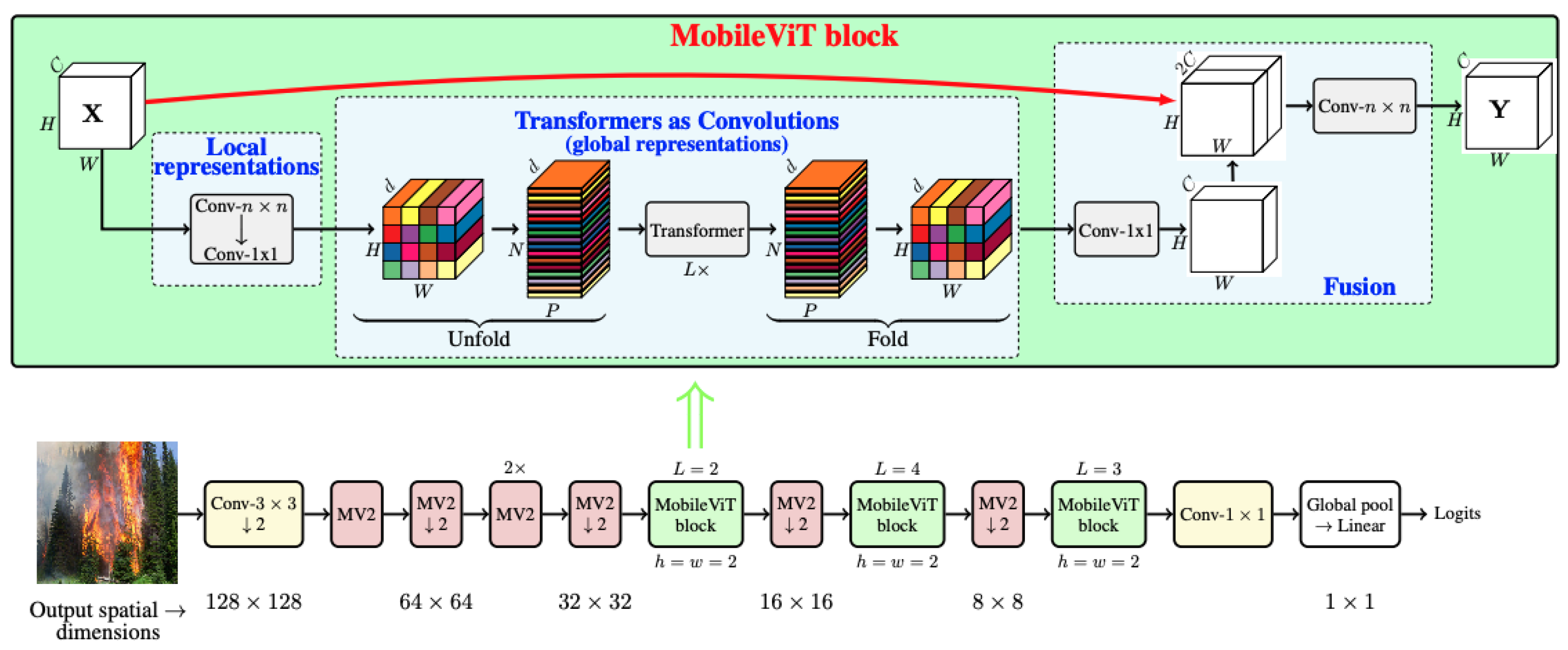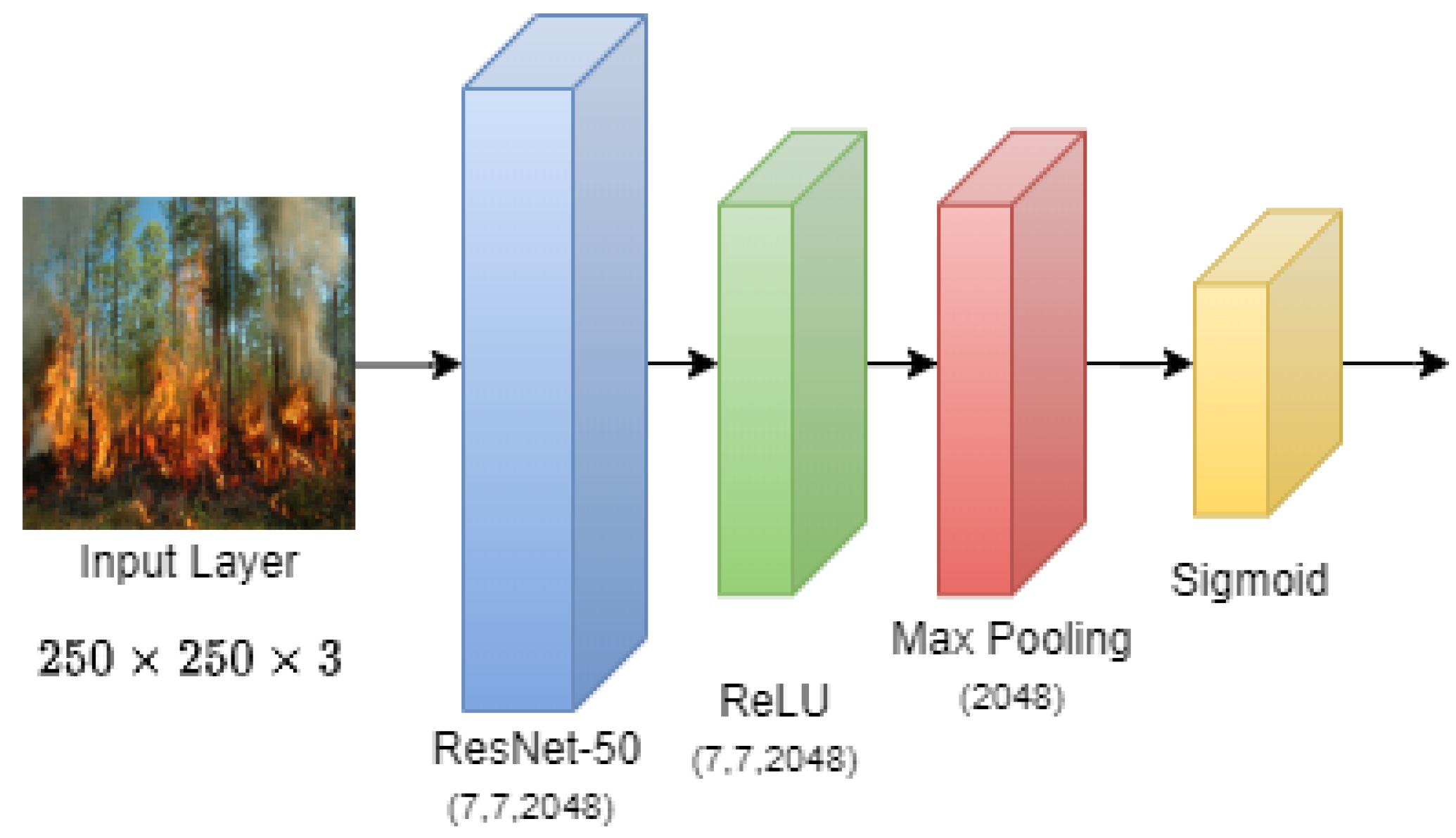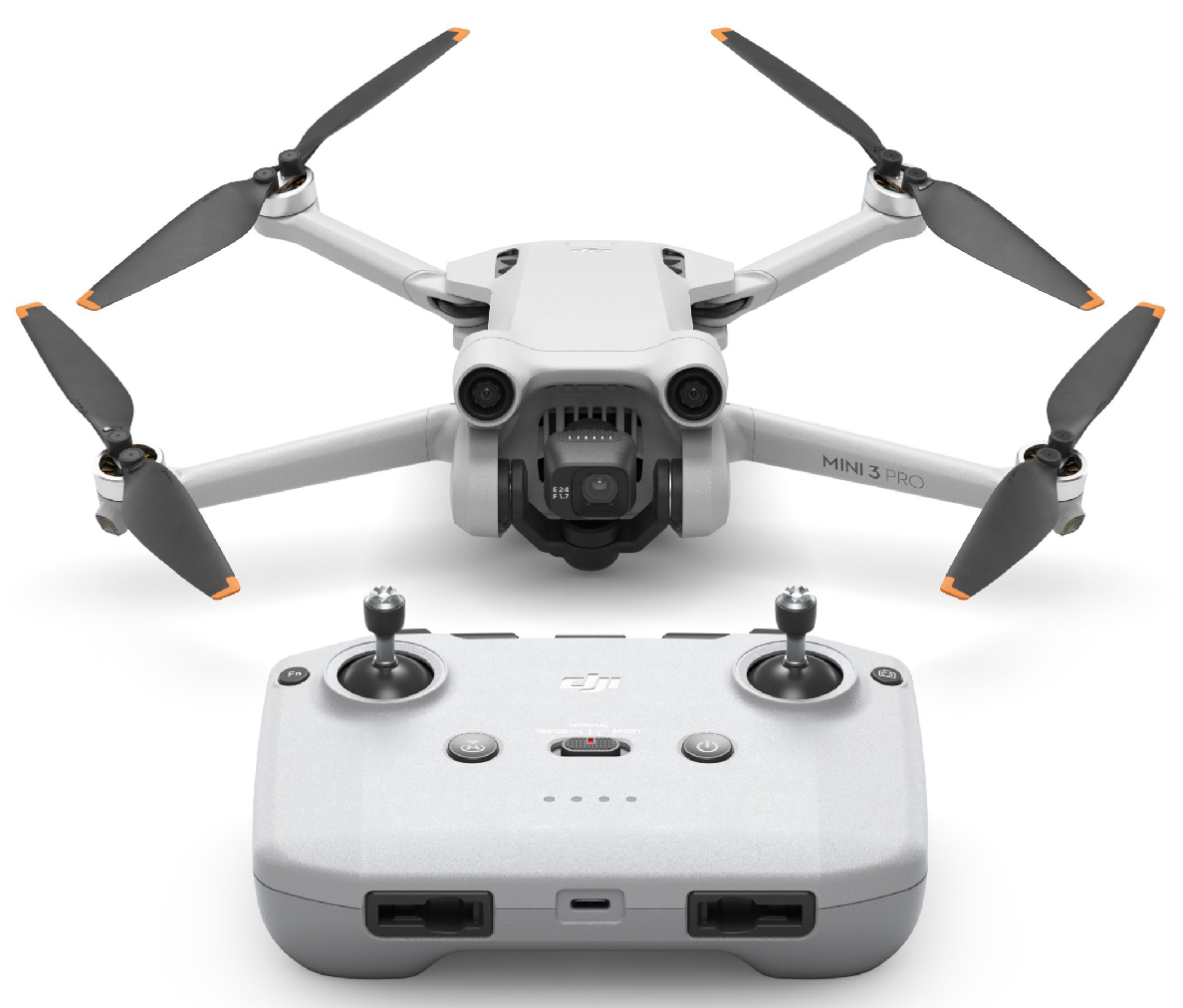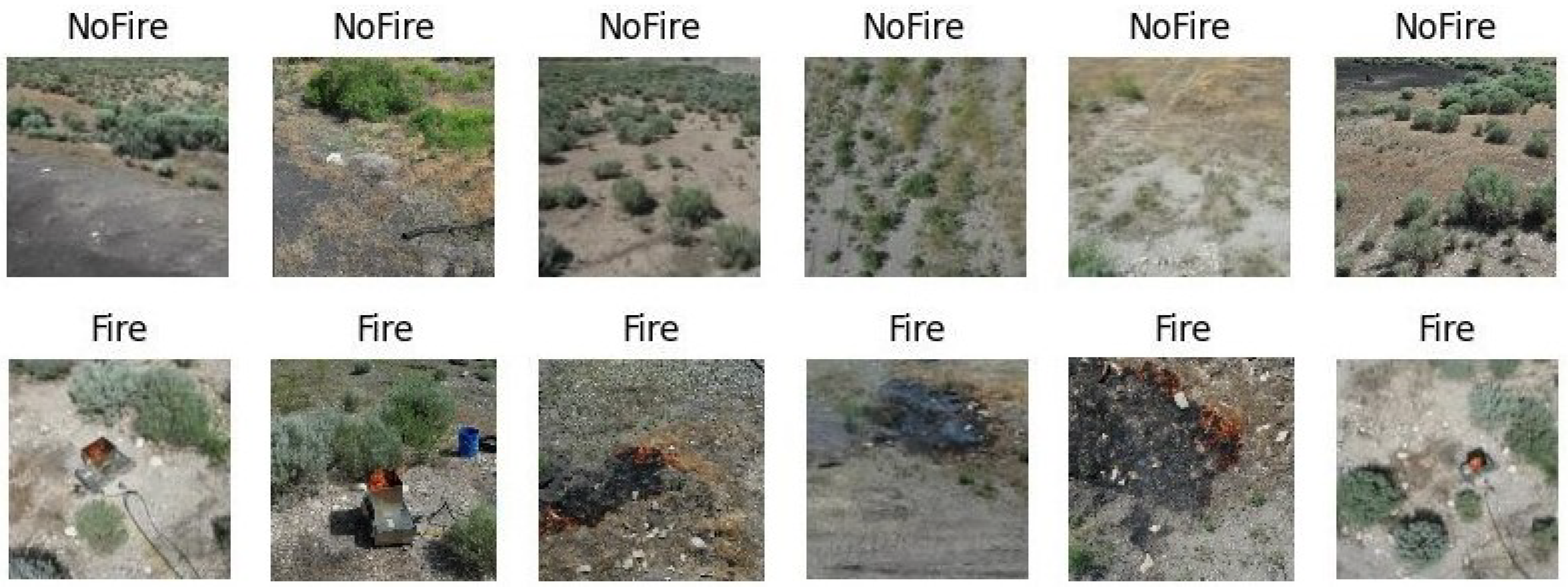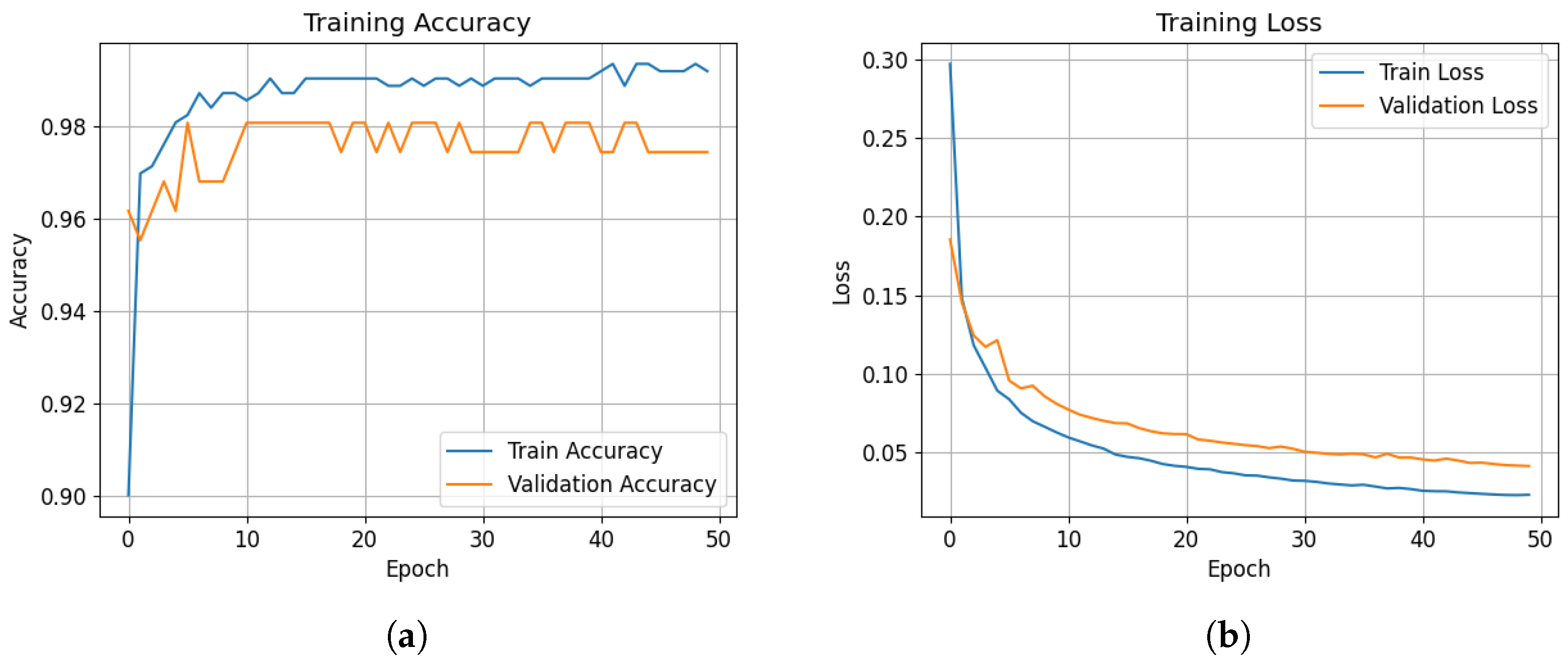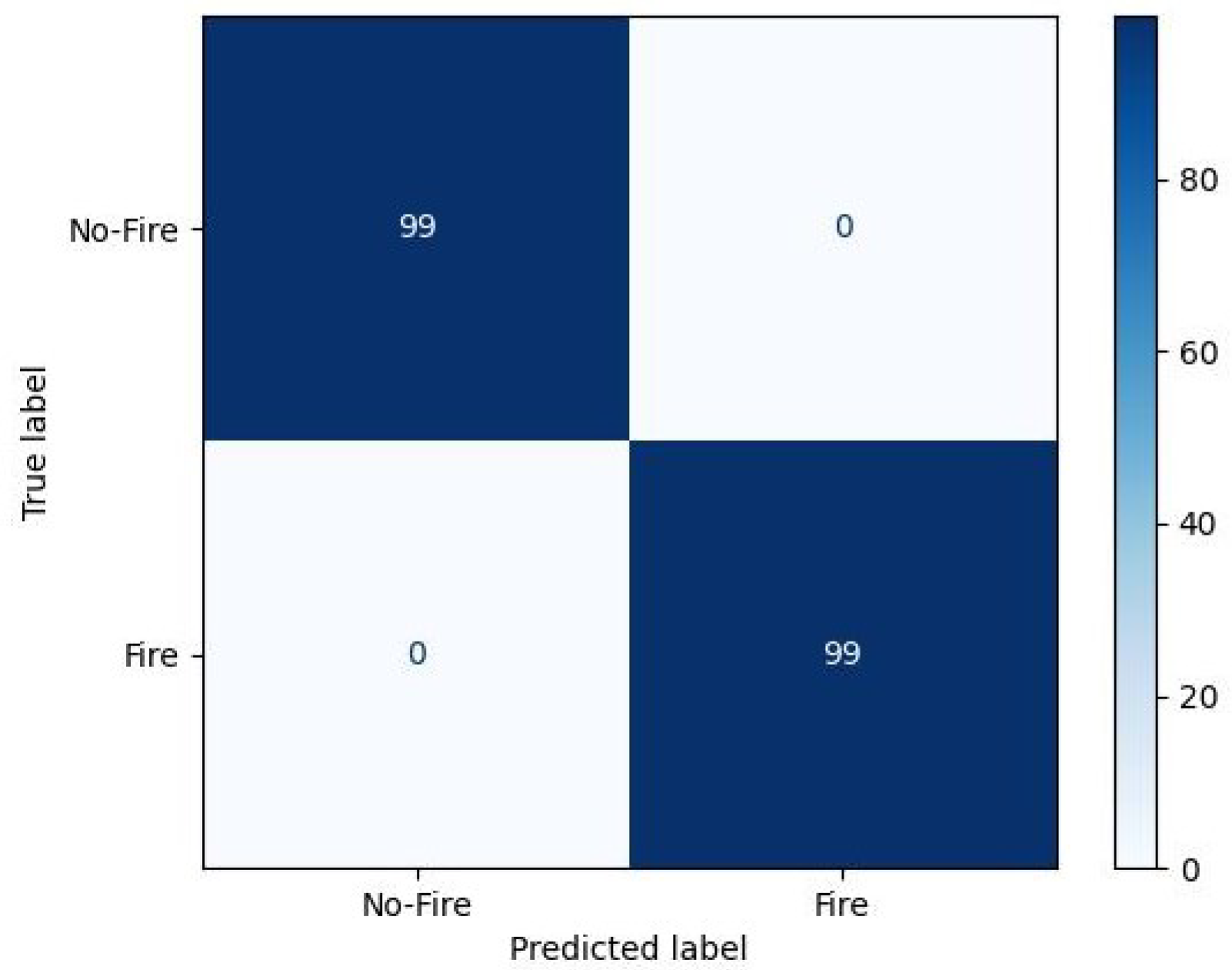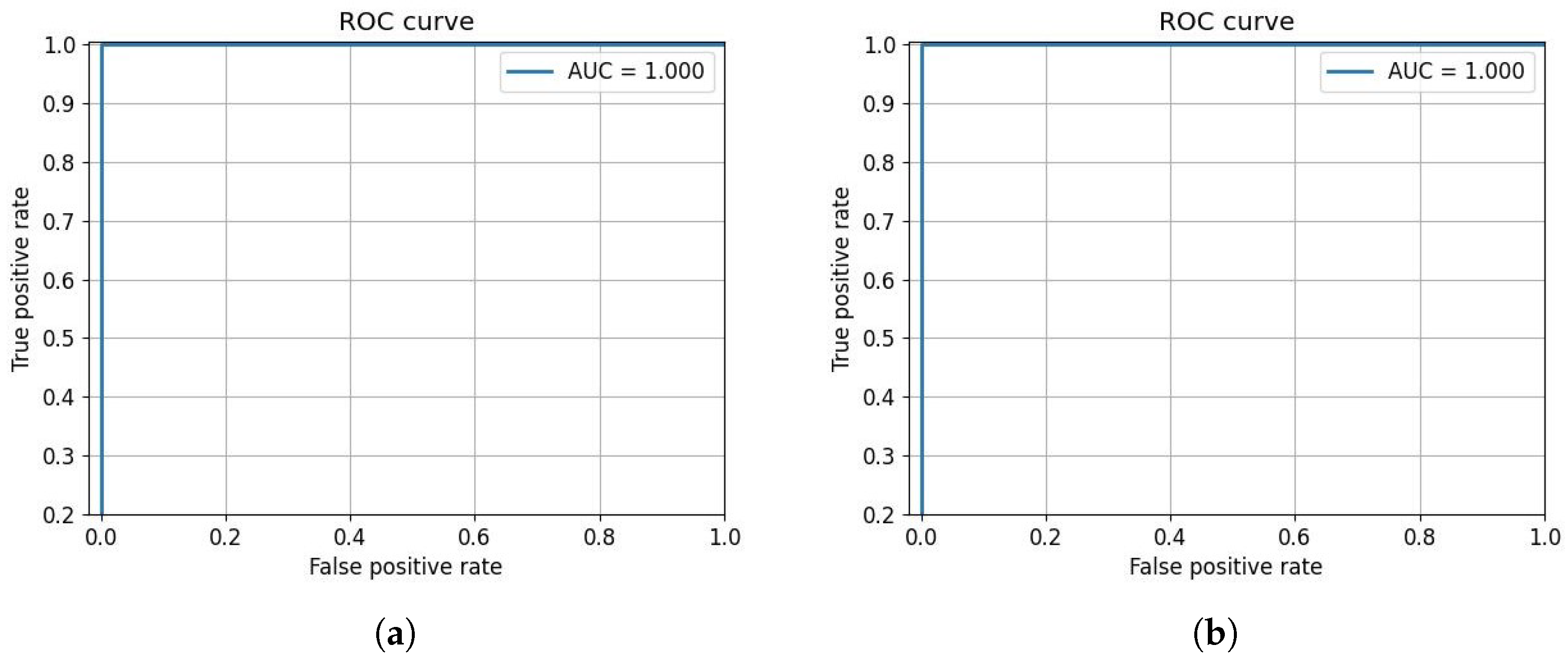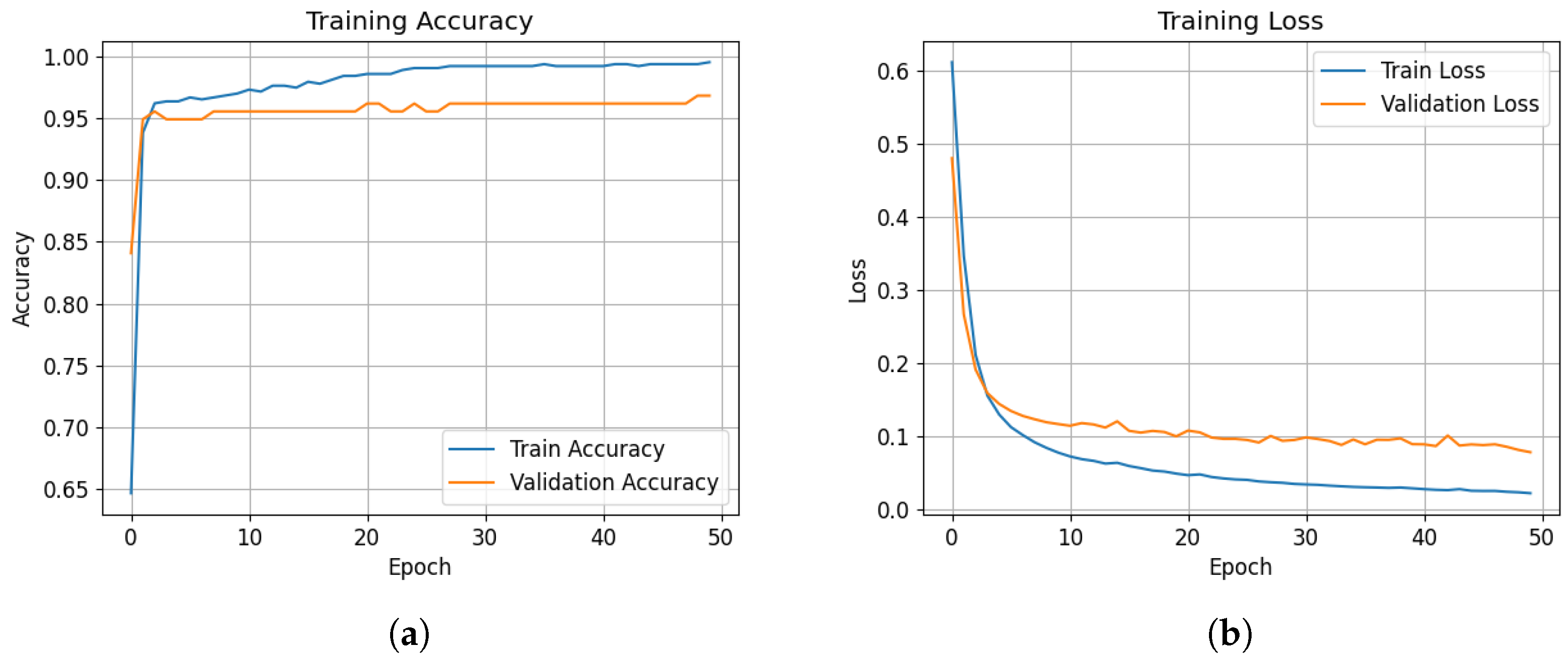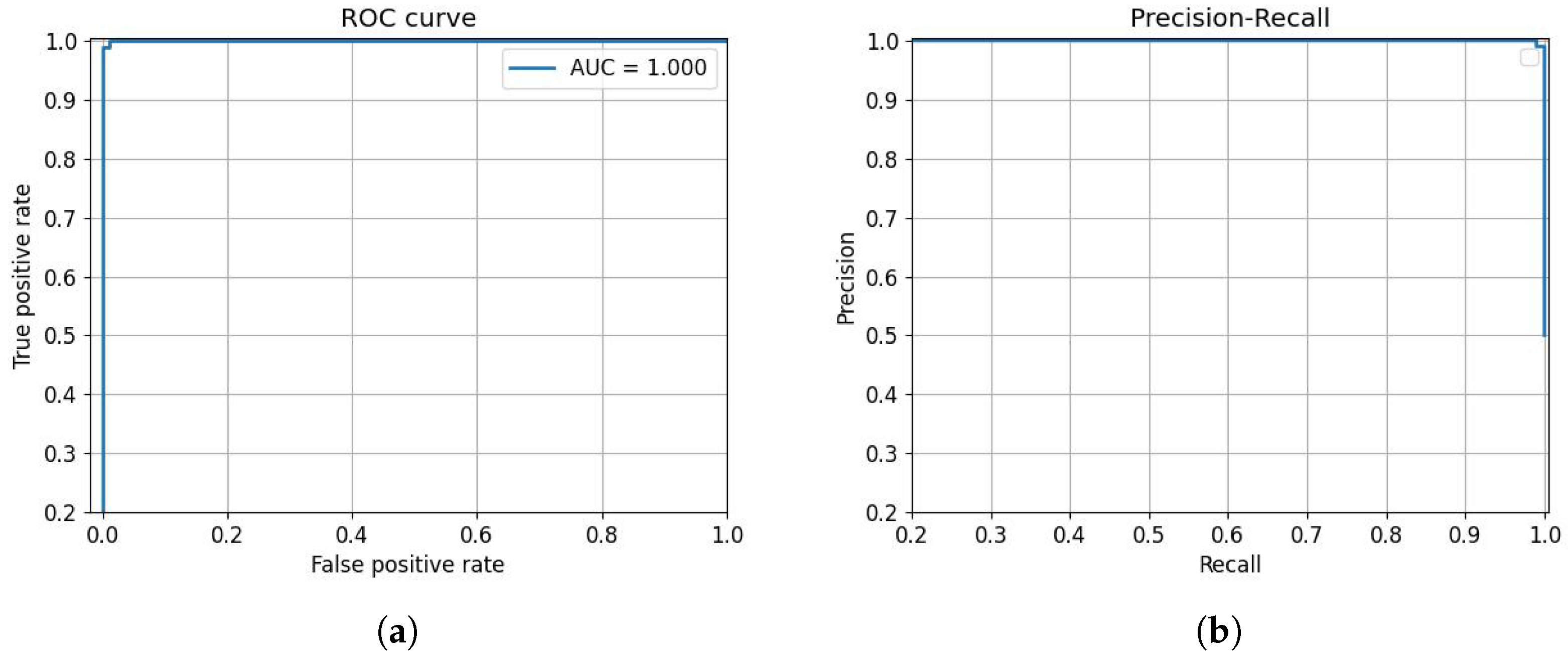1. Introduction
Wildfires are both ecological and economic disasters. These fires are characterized as uncontrolled and unpredictable fires in areas with combustible vegetation. According to recent reports, human-caused fires account for the majority at 89%, while other natural causes occur at a less frequent rate [
1,
2]. Natural causes such as lightning can be hard to detect as if they strike in remote areas, they may only be noticed after being developed into a sizeable fire. The destruction of environments due to fire also causes side effects on the ecosystem and surrounding communities. In desert environments, fire has been associated with the elimination of vegetation and increased probability of erosion [
3]. These destructive fires also harm soil biological components that are vital for the maintenance of native plant species [
3]. Catastrophic and fast-evolving fires also endanger and deteriorate the health of the surrounding communities. The smoke and particulates are known to cause lung and eye irritation while long exposure can lead to decreased lung function, exacerbation of asthma, and bronchitis [
4].
Given deserts’ inherently arid and barren nature, the susceptibility to wildfires is historically low. However, with the increase in invasive plant species and sporadic heavy rainfall, the flammability of these regions is increasing [
5]. These implications are further highlighted in the recent Dome Fire located in the Mojave Desert, California. In 2020, a lightning strike caused a small fire that rapidly developed and destroyed 17,512 hectares (Ha) of the national park, along with 1.3 million Joshua trees [
6]. As another such instance, the York Fire has been California’s largest wildfire of 2023 [
7]. With the increased precipitation driving vegetation growth in the area, this fire destroyed 37,667 Ha of land [
7]. It turns out that invasive species are an increasingly significant driver of desert fires. It has been shown that invasive plant species can quickly recover after fire, resulting in the cyclical increase of fire probability and the spread of invasive species [
8,
9]. While these factors contribute to increasingly violent desert fires, forest fires remain a major concern.
Forests not only provide resources such as food, fuel, and shelter to species but also help clean the air by absorbing carbon dioxide and preventing erosion by dissipating rainfall and slowing runoff with their root system [
10]. While forest fires are not a new phenomenon, they are increasing in size and quantity inducing a larger loss of life, resources, and capital. Since 1960, the top five largest wildfires by acreage burned in the United States occurred from 2007–2020 [
2]. Forest fires do not only affect the United States but also the global community at scale. Canada, which makes up 9% of the world’s forests, is having one of its worst fire years to date. According to the National Wildland Fire Situation Report, as of 21 June 2023, there have been a reported 2765 fires which is already above the 10-year average of 2068. While the acreage burned is monumental, the area is just shy of 6 million hectares. This far exceeds the 10-year average of 393,746 hectares [
11]. As another example, Russia is home to 20% of the world’s forests and has seen a similar trend of devastating fire behavior. From 2001 to 2021, Russia lost 52.8 Mha of tree cover from fires with the greatest loss during the 2021 fire season [
12].
The magnitude and quantity of fires have been increasing year over year and researchers have started to study the climate change trends in tandem with wildfire statistics. As a consequence of the greenhouse effect, the temperature is becoming higher globally with a predicted increase of 5–6 C by the year 2100 [
13]. Temperature extremes drive environments that foster volatile wildfires, increasing in quantity and intensity [
14]. Brown et al. investigated the tie between climate change and wildfires [
15]. By comparing the energy release component index from 1975 to 1996 against a model that calculated the expected rises due to climate change, they found that areas such as the Great Basin will undergo longer fire seasons [
15].
Due to the large economic cost of fighting wildfires and the changing conditions that foster faster-growing fires, local and national leaders have pushed for preventative and control measures in recent years. Thanks to advances in computing power and the availability of state-of-the-art processing power, computer vision and deep learning have been recently applied to the problem of early fire detection. The recent boom in the popularity of neural networks and deep learning is due to the increase in computational performance and availability of modern graphics processing units (GPUs). GPUs can be used to implement these architectures and provide an excellent computational performance boost with up to 20× the speed of CPU-only processing [
16]. This has been utilized by researchers for early fire detection to improve the training time and performance on large datasets. However, the desert fire detection using this technology has not been studied or addressed seriously.
Dawar et al. used a dataset consisting of satellite imagery of Canadian forest fires and it was shown that their proposed convolutional neural network (CNN) model outperformed Alexnet, Xception, MobileNet, and Lenet5 with the accuracy of 95.14% [
17]. In another study, Nallakaruppan et al. compared deep learning architectures on satellite images of fire with DenseNet-201 outperforming Inception, ResNet-50, and VGG-16 with an accuracy of 98.46% [
18].
By applying transfer learning and making use of pre-trained weights for the forest fire detection problem, researchers have seen increases in performance and accuracy. In this regard, Khan et al. proposed a transfer learning approach utilizing VGG-19 as the base network. When compared to K-nearest neighbors, SVM, Naïve Bayes, and Logistic regression, it was concluded that the transfer learning approach was superior with an accuracy of 95% on the DeepFire dataset [
19]. Following their initial work, Khan and Khan furthered their research and proposed a novel approach to fire detection refered to as FFireNet. FFireNet was developed using MobileNetV2 as the backbone and modifying the fully connected layers at the end with ReLU and sigmoid functions. This approach proved beneficial as it performed well on the DeepFire dataset achieving 98.42% accuracy and outperformed other architectures such as Xception, InceptionV3, and ResNet152V2 [
20]. On the same dataset, a particle swarm-based federated learning approach was evaluated by Supriya and Gadekallu [
21]. Overcoming the hurdles of communication lags and transmission processing power, their proposed approach achieved 94.47% accuracy on the test data [
21]. Namburu et al. also leveraged transfer learning with MobileNet, adding a flattened, dense, and softmax layer for the purpose of fire classification. Their proposed method, X-MobileNet, achieved 98.89% accuracy on a large dataset created using drone footage [
22]. Idroes et al. proposed TeutongNet with the use of ResNet-50 as their backbone architecture [
23]. This architecture is made based on a pre-trained ResNet-50 and adding global average pooling, dense, dropout, and sigmoid layers. TeutongNet was trained and tested on the DeepFire dataset and achieved 98.68% accuracy [
23]. Alice et al. also employed ResNet-50 as the feature extraction to their proposed fire detection model referred to as AFFD-ASODTL. By combining ResNet-50 with a Quasi-Recurrent neural network for classification, they were able to reach 97.33% accuracy and surpassed other architectures on their created dataset [
24].
Another area of fire detection research that is increasing in popularity is real-time detection and classification. This area uses machine learning for classification as well as tracking and relaying data about the fire in real-time. In this case, Wu and Zhang investigated three architectures, You Only Look Once (YOLO), Single Shot Detector (SSD), and Region based convolutional neural networks (R-CNN), for real-time forest fire detection and their relative performance. The models were trained using images of smoke and fire in different environments, both forest and urban, to train the models to detect and segment both fire and smoke. Experimentally, they concluded that the YOLO algorithms had poor performance on small and cool fires. To resolve this issue, Wu and Zhang altered the structure of YOLO by adding one more convolutional and max-pooling layer. With these modifications, Faster R-CNN and SSD provided the best performance still at 99.7% and 99.88% for fire detection, respectively [
25]. Jin and Lu made use of these real-time processing techniques to detect movement as part of a proposed fire detection process. This included the combination of real-time data, feature extraction, and classification for fire detection. Through comparative analysis of algorithms for extraction and classification steps, Jin and Lu concluded that AdaBoost and Naïve Bayes were the leading algorithms for low and high-dimensional classifiers, respectively. With these in place, the performance of their approach on evaluation data was 97.33% [
26]. A large hurdle for real-time detection and edge computing is the balance of size and performance. To overcome the large computational costs of traditional real-time detection methods, in [
27] the authors proposed a lightweight YOLOv7 architecture for deployment in UAV’s for the purpose of smoke classification. Altering traditional YOLOv7 with reduced computational convolutions, activation functions, and the reassembly of features, their model provided high accuracy while significantly cutting size and computational cost. Measuring the Giga floating point operations per second (GFLOPs), this novel approach improved the performance by 6% over the baseline YOLOv7 [
27].
While wildfires affect forest environments heavily, the review of existing literature revealed a need for the investigation of desert fire features. In order to investigate detection methods in these diverse environments, new datasets need to be created and are required to be fed to the models during the training period. This lack of desert feature representation in popular fire datasets was also highlighted in [
28]. To tackle this problem, we propose a new dataset which includes 986 total fire and no-fire images for use with fire classification models. This new dataset, Utah Desert Fire, was created to analyze the models in fire feature extraction and classification abilities. This dataset was created in a desert environment which provides valuable insight into the capability of fire detection in diverse conditions.
In this paper, we explore the performance of four existing architectures and propose two novel approaches for fire classification. The models were tuned and trained on this newly proposed dataset with resulting performance comparisons drawn. Following these comparisons, the proposed models were trained and tested on the popular DeepFire dataset created by Khan et al. to compare performance with recent proposed architectures in the literature [
19].
The following outlines the contributions and flow of this research:
Review of the existing research in fire detection with the focus on desert and forest fires.
Creation of a novel desert fire detection dataset, Utah Desert Fire.
Proposal of modified transfer learning approaches for Xception and ResNet-50.
Hyperparameter tuning and testing for the best performance on the proposed Utah Desert Fire dataset.
Comparison of SVM, Xception, ResNet-50, and MobileViT architectures performance against proposed models on the Utah Desert Fire dataset.
Comparison of our proposed models performance with exisiting solutions in the literature on the DeepFire dataset [
19].
The following sections will discuss the architectures and approaches proposed, the methods used for tuning and finding best performance, followed by resulting performance and literature comparisons.
